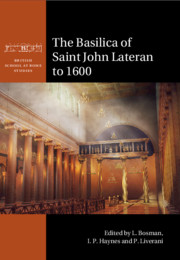Book contents
- The Basilica of Saint John Lateran to 1600
- British School at Rome Studies
- The Basilica of Saint John Lateran to 1600
- Copyright page
- Contents
- Figures
- Contributors
- Acknowledgements
- Abbreviations
- 1 The Lateran Basilica to 1600
- 2 The Evolution of the Lateran: From the Domus to the Episcopal Complex
- 3 At the Foot of the Lateran Hill, from Via Sannio to Viale Ipponio: Archaeological Investigations Prior to the Construction of Metro Line C
- 4 Ground-Penetrating Radar Survey in the Saint John Lateran Basilica Complex
- 5 The First Residential Phases of the Lateran Area and a Hypothesis to Explain the So-Called Trapezoidal Building
- 6 The Castra Nova and the Severan Transformation of Rome
- 7 Andrea Busiri Vici and the Excavations of 1876: A Reassessment of the Archaeological Evidence
- 8 Visualising the Constantinian Basilica
- 9 Constantine’s Spolia: A Set of Columns for San Giovanni in Laterano and the Arch of Constantine in Rome
- 10 The Constantinian Basilica in the Early Medieval Liber Pontificalis
- 11 The Lateran Baptistery in the Fourth and Fifth Centuries: New Certainties and Unresolved Questions
- 12 The Nymphaeum of Pope Hilarus
- 13 Examples of Medieval Construction Techniques in the Basilica of San Giovanni in Laterano
- 14 The Medieval Portico of Saint John Lateran
- 15 MATER ET CAPUT OMNIUM ECCLESIARUM: Visual Strategies in the Rivalry between San Giovanni in Laterano and San Pietro in Vaticano
- 16 The Remodelling of San Giovanni in Laterano by Pope Nicholas IV: Transept, Apse and Façade
- 17 Furtum Sacrilegum: The ‘Holy Heads’ of Peter and Paul and Their Reliquaries in the Lateran
- 18 Reconsidering the Traces of Gentile da Fabriano and Pisanello in the Lateran Basilica
- 19 The Rite of the Reconciliation of Penitents at the Lateran Basilica
- 20 The New Passion Relics at the Lateran, Fifteenth to Sixteenth Centuries: A Translocated Sacred Topography
- 21 The East Façade of the Complex of Saint John Lateran in the Modern Era
- 22 The Book of Acts in the Constantinian Basilica: Cardinal Cesare Baronio and the Navata Clementina in San Giovanni in Laterano
- Bibliography
- Index
19 - The Rite of the Reconciliation of Penitents at the Lateran Basilica
Published online by Cambridge University Press: 27 August 2020
- The Basilica of Saint John Lateran to 1600
- British School at Rome Studies
- The Basilica of Saint John Lateran to 1600
- Copyright page
- Contents
- Figures
- Contributors
- Acknowledgements
- Abbreviations
- 1 The Lateran Basilica to 1600
- 2 The Evolution of the Lateran: From the Domus to the Episcopal Complex
- 3 At the Foot of the Lateran Hill, from Via Sannio to Viale Ipponio: Archaeological Investigations Prior to the Construction of Metro Line C
- 4 Ground-Penetrating Radar Survey in the Saint John Lateran Basilica Complex
- 5 The First Residential Phases of the Lateran Area and a Hypothesis to Explain the So-Called Trapezoidal Building
- 6 The Castra Nova and the Severan Transformation of Rome
- 7 Andrea Busiri Vici and the Excavations of 1876: A Reassessment of the Archaeological Evidence
- 8 Visualising the Constantinian Basilica
- 9 Constantine’s Spolia: A Set of Columns for San Giovanni in Laterano and the Arch of Constantine in Rome
- 10 The Constantinian Basilica in the Early Medieval Liber Pontificalis
- 11 The Lateran Baptistery in the Fourth and Fifth Centuries: New Certainties and Unresolved Questions
- 12 The Nymphaeum of Pope Hilarus
- 13 Examples of Medieval Construction Techniques in the Basilica of San Giovanni in Laterano
- 14 The Medieval Portico of Saint John Lateran
- 15 MATER ET CAPUT OMNIUM ECCLESIARUM: Visual Strategies in the Rivalry between San Giovanni in Laterano and San Pietro in Vaticano
- 16 The Remodelling of San Giovanni in Laterano by Pope Nicholas IV: Transept, Apse and Façade
- 17 Furtum Sacrilegum: The ‘Holy Heads’ of Peter and Paul and Their Reliquaries in the Lateran
- 18 Reconsidering the Traces of Gentile da Fabriano and Pisanello in the Lateran Basilica
- 19 The Rite of the Reconciliation of Penitents at the Lateran Basilica
- 20 The New Passion Relics at the Lateran, Fifteenth to Sixteenth Centuries: A Translocated Sacred Topography
- 21 The East Façade of the Complex of Saint John Lateran in the Modern Era
- 22 The Book of Acts in the Constantinian Basilica: Cardinal Cesare Baronio and the Navata Clementina in San Giovanni in Laterano
- Bibliography
- Index
Summary
The Lateran Basilica hosted three pivotal papal liturgies of the Roman ecclesiastical calendar – Palm Sunday, Maundy Thursday, and the Easter Vigil.Due to their importance and infrequency, these feasts are well described in medieval sources.These celebrations, which commemorated the death and resurrection of Jesus, featured unique and dramatic observances such as the blessing and distribution of palms, the blessing of new oils, the washing of feet, the lighting of the new paschal candle, the chanting of fitting Biblical texts, and the baptism of infants.The action of the liturgy made use not only of the church, but also of the atrium and the baptistery of the Lateran.Although worship is sometimes characterized as having become ossified in the Middle Ages, the clergy did in fact allow modification and even experimentation in their liturgies.Perhaps the greatest single change came in the rite of reconciliation of penitents on Maundy Thursday, which once had the pope interceding for the people of the city for forgiveness of their sins; this allowed them to rejoin the faithful in taking the Eucharist at Mass.However, starting in the thirteenth century, the pope took the opportunity to excommunicate sinners to exclude them from the Eucharist.
- Type
- Chapter
- Information
- The Basilica of Saint John Lateran to 1600 , pp. 400 - 427Publisher: Cambridge University PressPrint publication year: 2020



